Handling High-Stakes Conversations: 9 Tips for Leaders

Handling emotionallycharged conversations skillfully is crucial to being a successful leader, butmany leaders lack the know-how. The Workplace Coach is here to help.
Maybe youneed to broach a contentious topic with a boss, strategic partner or colleague,or bring up a sensitive issue with a team member. You might have to tell a teammember something they don’t want to hear, or navigate strong differences ofopinion. Whatever the specifics, having those types of conversations is reallytough for most of us.
While suchhigh-stakes conversations are challenging, they are also an opportunity toshine as a leader. They can even spark profound positive change. But beforewarned: If handled poorly, these conversations can really hurt relationshipsand even harm your reputation.
Followingare tips from The Workplace Coach.
1. Preparementally & emotionally
Before theconversation, think about the desired outcomes. Be aware of any anxieties,fears or biases you have that might cause you to engage in unproductivebehaviors such as blaming. Take a deep breath and ground yourself so you bring clarity,calm and purpose to the conversation.
2. Setthe stage for success
Begin theconversation by acknowledging the emotions involved and commenting on the positivesin the situation. Seek to defuse the conversation and facilitate trust byshowing empathy, setting a tone of respect and being open and honest.
3. Focuson shared objectives
Aim formutual understanding Focus on finding common ground, rather than going for thewin. Remind others in the conversation that this is the shared goal, then invitedialogue by asking open-ended questions. Look for ways to reframe the issue asan opportunity to create something new together.
4. Bean active & curious listener
Listenwith keen attention and maintain eye contact. Focus on understanding the otherperson’s viewpoint, rather than thinking about what you want to say. Payattention to nonverbal cues that signal unspoken concerns. When you do respond,start by paraphrasing what you heard the other person say. This allows them to feelheard and ensures understanding.
5. Speakskillfully
Keepshared objectives in the forefront of your mind when you speak. Frame your opinionsand perspective as being your observations. When giving feedback, be specificand factual. Avoid being judgmental or making the other person wrong. Ratherthan negating someone’s idea, ask them to explain their thinking.
6. Acknowledgedifferences
It’s okayto have differing opinions. Instead of pushing back immediately, acknowledgethe difference, and try to understand its root cause. Work at being open todiffering viewpoints. Often, this openness can lead to new insights andresolutions.
7. Choosethe right setting
Choose asetting that is private, free from interruptions and puts both parties at ease.Put away your devices and ask others to do the same so that everyone is fullypresent.
8. Staycalm & focused
Even ifthe conversation becomes heated, it's crucial that you, as leader, remain calm.Take deep breaths and pause when necessary. Remember your role is to guide thediscussion towards a constructive outcome.
9. Followup & reflect
After ahigh-stakes conversation, it’s a good idea to schedule a follow-up. Thisprovides an opportunity to reflect on the dialogue, clarify lingering concerns anddiscuss the way forward. As a leader, you’ll also want to reflect on your ownperformance, perhaps with the input of an executive coach or leadership coach.
Like it ornot, handling high-stakes conversations is an essential part of leadership.
Withpreparation, a commitment to mutual understanding and skilled listening, you canturn these conversations into defining moments that improve collaboration andrelationships. The key is to approach the conversation with the right intentand a willingness to learn and grow.
ABOUT THEWORKPLACE COACH: The Workplace Coach has deep expertise in business leadership.For more than two decades, its award-winning coaches have been partnering withexecutive coaching and leadership coaching clients and organizations to helpthem achieve their strategic goals. Leadership coaching clients report successin developing their leadership agility, CEO mindset and executive presence andin using leader-as-coach tools to improve employee engagement and productivity.
Contact The Workplace Coach toprepare your leaders for high-stakes conversations.
Get Practical and Actionable Insights Delivered Monthly
Sign up for our blog now so you never miss out on our expert advice and tips.
Other Blogs

Resilient Leadership in Uncertain Times: 5 Signposts to Reset for the New Year

Assessments: The Key to Leadership Evolution





